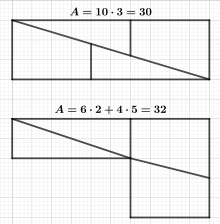Paradox by Hooper
The paradox of Hooper is a geometric fallacy in which a figure is divided into four parts, which are then assembled to form a rectangle whose surface area than the surface area of the original figure lower by two units of area.
Analysis of the sham paradox
On closer inspection you can see that the dimensions of the two triangles in the (lower) initial figure do not match those of the triangles in the rectangle. The smaller cathetus is exactly 2 units of length in the initial figure, while it is only 1.8 units of length in the rectangle. Therefore, if you use the triangles of the starting figure in the rectangle, they overlap a little, whereby the area of a narrow parallelogram is lost. The sides and diagonals of the parallelogram can be calculated using the Pythagorean theorem .
The area of half the parallelogram can be calculated using the Heron formula, which results in the halved circumference of the triangle or half the parallelogram
and thus for the area of the entire parallelogram
- .
The surface that has apparently disappeared corresponds exactly to the parallelogram-shaped overlapping surface of the four parts of the original figure.
history
William Hooper published the pseudo-paradox named after him in 1774 under the title The geometric money in his four-volume work Rational Recreations, but still with an incorrect drawing and calculation, which was corrected in the 1782 edition. However, the paradox does not go back to Hooper himself, whose book was essentially a translation of the Nouvelles récréations physiques et mathétiques by the French Edmé Gilles Guyot (1706–1786). This four-volume work was published in France in 1769 and contained the same false drawing and invoice in its first edition.
literature
- Martin Gardner : Mathematics, Magic and Mystery . Courier (Dover), 1956, ISBN 9780486203355 , pp. 129-155
- Greg N. Frederickson: Dissections: Plane and Fancy . Cambridge University Press, 2003, ISBN 9780521525824 , Chapter 23, pp. 268–277 in particular pp. 271–274 ( online update to Chapter 23 )
- Simon During: Modern Enchantments: The Cultural Power of Secular Magic . Harvard University Press, 2004, ISBN 978-0674013711 , p. 87
- William Hooper: Rational Recreations . London, 1774, p. 286 (incorrect first edition)
- William Hooper: Rational Recreations . London, 1782, p. 286 (corrected edition)
Web links
- Hooper's Paradox: How Is It Possible? on cut-the-knot.org
- Mariano Tomatis: Curse of the crystal skulls and other vanishing area puzzles







